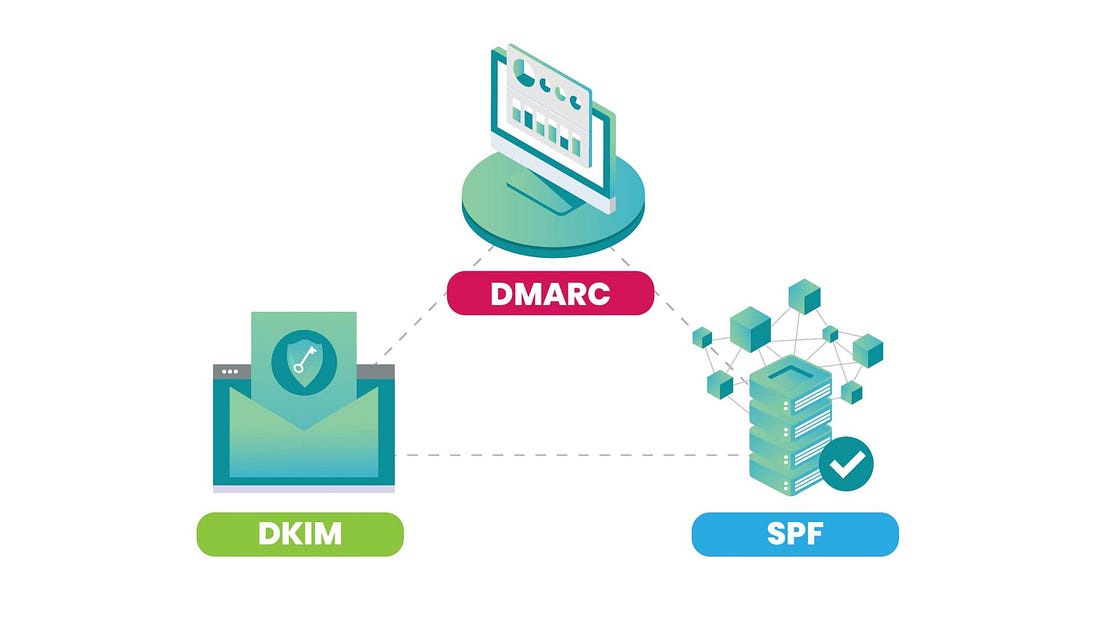In the digital age, email is the backbone of communication. It’s not just a tool for sharing cat memes or coordinating weekend plans; it’s a cornerstone of business operations. Unfortunately, as email’s importance has grown, so too has the threat of malicious actors seeking to exploit it. Enter SPF, DKIM, and DMARC – three crucial defenses that every organization should implement to protect against email phishing and ensure secure communication.
The Anatomy of Email Phishing
Email phishing is a cybercrime that hinges on deception. Attackers impersonate legitimate entities, often using familiar names or logos, to trick recipients into revealing sensitive information or performing malicious actions. To defend against these insidious attacks, you need more than just a keen eye; you need a robust email security framework.
SPF (Sender Policy Framework)
What is SPF?
The Sender Policy Framework (SPF) is a critical component of email authentication. It is designed to prevent email spoofing by specifying which mail servers are authorized to send email on behalf of a particular domain. SPF records are DNS (Domain Name System) records that help email receivers verify the legitimacy of incoming messages.
How does SPF work?
SPF records are essentially a list of authorized senders for a domain. When an email server receives a message, it checks the SPF record of the sender’s domain to determine if the sending server is authorized to send on behalf of that domain. If the sending server is not on the authorized list, the email may be flagged as suspicious or rejected.
Example of an SPF record:
Suppose you want to authorize two servers (mailserver1.com and mailserver2.com) to send email on behalf of your domain (yourcompany.com). Your SPF record might look like this:
yourcompany.com. IN TXT "v=spf1 mx a:mailserver1.com a:mailserver2.com -all"
In this example, “v=spf1” indicates that this is an SPF record, “mx” allows servers listed as mail exchangers, and “a” authorizes the specified servers. “-all” indicates that all other servers should be rejected.
DKIM (DomainKeys Identified Mail)
What is DKIM?
DomainKeys Identified Mail (DKIM) is another layer of email authentication. It adds a digital signature to outgoing emails, which can be verified by the recipient’s email server. DKIM ensures the email’s integrity and origin, making it challenging for attackers to alter messages in transit.
How does DKIM work?
When an email is sent with DKIM, the sending server generates a unique cryptographic signature based on the email’s content and adds it as a DKIM header. The recipient’s email server then uses the public DKIM key published in DNS to verify the signature. If the signature matches, the email is considered legitimate; otherwise, it’s flagged as potentially fraudulent.
Example of a DKIM record:
A DKIM record typically includes a selector (a name associated with the key) and the public key itself. Here’s an example of a DKIM record for yourcompany.com:
selector._domainkey.yourcompany.com. IN TXT "v=DKIM1; k=rsa; p=MIGfMA0GCSqGSIb3DQEBAQUAA4GNADCBiQKBgQCX5SLE5rPccJJki+e/DV1ZLXbnCw7RlYp+XhdbnI2KmXDCGnFypNjOnkuyzH7KsGZ9DNU1iCA2FYJ/2X6Z4M3Kr0OBuR+I2vPfnPb6PjVXroJmYKyU+Zz7vj5m3FqN1u6DP4I8Yfd7W58DRCY7O1otP6YsVKLyJ7b4U7/P3sPFrgS2R+Glf6wIDAQAB"
This record specifies the DKIM version, key type (rsa), and the actual public key.
DMARC (Domain-based Message Authentication, Reporting, and Conformance)
What is DMARC?
While SPF and DKIM provide individual security layers, DMARC ties them together into a comprehensive email authentication protocol. DMARC, which stands for Domain-based Message Authentication, Reporting, and Conformance, enables domain owners to specify how SPF and DKIM should be handled when an email claiming to be from their domain is received.
How does DMARC work?
DMARC allows domain owners to set policies for handling emails that fail SPF and DKIM checks. These policies can range from “none” (no specific actions) to “quarantine” (put the email in the spam folder) or “reject” (don’t deliver the email at all). DMARC also provides reporting capabilities, allowing domain owners to monitor email traffic and identify potential issues.
Example of a DMARC record:
Here’s an example DMARC record for yourcompany.com:
_dmarc.yourcompany.com. IN TXT "v=DMARC1; p=reject; rua=mailto:dmarc-reports@yourcompany.com; ruf=mailto:dmarc-forensics@yourcompany.com; sp=reject"
In this record, “p=reject” indicates that emails failing SPF or DKIM checks should be rejected. The “rua” and “ruf” fields specify email addresses where DMARC reports should be sent, helping you monitor and analyze email traffic.
The Synergy of SPF, DKIM, and DMARC
While SPF, DKIM, and DMARC each offer protection on their own, their true power is realized when combined. Together, they create a formidable defense against email phishing and spoofing. Here’s how they work together:
-
SPF ensures the right servers send emails on behalf of your domain. It prevents attackers from sending fraudulent emails that claim to be from your domain.
-
DKIM adds a cryptographic signature to your emails. This signature proves the email’s authenticity and integrity, making it harder for attackers to tamper with your messages.
-
DMARC sets policies for handling emails that fail SPF and DKIM checks. It provides clear instructions on how email servers should treat suspicious messages.
The Bottom Line
In the ever-evolving landscape of cyber threats, email phishing remains a persistent danger. Implementing SPF, DKIM, and DMARC records is a proactive step toward bolstering your organization’s email security. These measures not only protect your brand’s reputation but also shield your recipients from falling victim to phishing scams.
Remember, setting up SPF, DKIM, and DMARC records requires careful planning and management. Consult with your IT department or a trusted email security provider to ensure these protocols are correctly configured and regularly monitored. By doing so, you’ll be fortifying your email communication and reducing the risk of cyberattacks that could have dire consequences for your organization.



